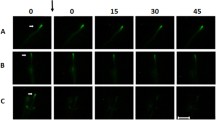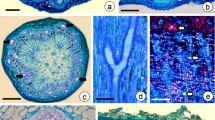Summary
The ultrastructural features of developing haustoria and associated haustorial mother cell septa were examined in the cowpea rust fungus,Uromyces phaseoli var.vignae. Significant changes occurred in the septal pore apparatus, and in structures associated with the septum, during the formation of a haustorium. The originally open septal pore became plugged with osmiophilic material and, on both sides of the septum, elaborations of the plasmalemma developed whose maximum growth coincided with the close association of numerous mitochondria. Those elaborations on the haustorial mother cell side consisted of irregular whorls and tangles of membranes and disappeared prior to the formation of the penetration peg. In contrast, the more tubular protrusions on the hyphal side of the septum reached their maximum length of about 900 nm during the breaching of the host cell wall but subsequently shrank rapidly until, by the time the haustorium was mature, they and their osmiophilic matrix adjacent to the septal wall had usually disappeared. By this time, the osmiophilic plug had also disappeared and the pore now resembled that most commonly seen in other portions of the vegetative mycelium in being covered on either side by a thin layer of osmiophilic material and in being surrounded by a region of differentiated cytoplasm bordered with microbodies. Little change in this septal pore apparatus was observed as the haustorium aged until the tonoplast of the haustorial mother cell broke down. At this time the differentiated regions of the cytoplasm, and the associated microbodies, disappeared from the haustorial mother cell side of the septum.
Previously undescribed stages in haustorium development were also observed during this investigation and revealed that the osmiophilic ring around the haustorium neck did not develop until the haustorium body was 2.5–3 μm in diameter. The significance of this observation, and of those associated with the haustorial mother cell septum, are discussed.
Similar content being viewed by others
References
Bushnell, W. R., 1972: Physiology of fungal haustoria. Ann. Rev. Phytopathology10, 151–176.
Coffey, M. D., B. A. Palevitz, andP. J. Allen, 1972: The fine structure of two rust fungi,Puccinia helianthi andMelampsora lini. Canad. J. Bot.50, 231–240.
Ehrlich, M. A., H. G. Ehrlich, andJ. F. Schafer, 1968: Septal pores in theHeterobasidiomycetidae, Puccinia graminis andP. recondita. Amer. J. Bot.55, 1020–1027.
Frederick, S. E., E. H. Newcomb, E. L. Vigil, andW. P. Wergin, 1968: Finestructural characterization of plant microbodies. Planta81, 229–252.
Giesy, R. M., andP. R. Day, 1965: The septal pores ofCoprinus lagopus in relation to nuclear migration. Amer. J. Bot.52, 287–293.
Grove, S. N., andC. E. Bracker, 1970: Protoplasmic organization of hyphal tips among fungi: vesicles and Spitzenkörper. J. Bact.104, 989–1009.
Heath, I. B., J. L. Gay, andA. D. Greenwood, 1971: Cell wall formation in theSaprolegniales: cytoplasmic vesicles underlying developing walls. J. gen. Microbiol.65, 225–232.
Heath, M. C., 1971: Haustorial sheath formation in cowpea leaves immune to rust infection. Phytopathology61, 383–388.
Heath, M. C., 1972: Ultrastructure of host and nonhost reactions to cowpea rust. Phytopathology62, 27–38.
, 1974: Light and electron microscope studies of the interactions of host and nonhost plants with cowpea rust-Uromycesphaseoli var.vignae. Physiol. Plant Pathol.4, 403–414.
andI. B. Heath, 1971: Ultrastructure of an immune and a susceptible reaction of cowpea leaves to rust infection. Physiol. Plant Pathol.1, 277–287.
Jones, D. R., 1973: Ultrastructure of septal pore inUromyces dianthi. Trans. Br. mycol. Soc.61, 227–235.
Littlefield, L. J., 1972: Development of haustoria ofMelampsora lini. Canad. J. Bot.50, 1701–1703.
, andC. E. Bracker, 1971: Ultrastructure of septa inMelampsora lini. Trans. Br. mycol. Soc.56, 181–188.
, 1972: Ultrastructural specialization at the host-pathogen interface in rust-infected flax. Protoplasma74, 271–305.
Moore, R. T., andJ. H. McAlear, 1962: Fine structure ofMycota. 7. Observations on septa of ascomycetes and basidiomycetes. Amer. J. Bot.49, 86–94.
Pate, J. S., andB. E. S. Gunning, 1972: Transfer cells. Ann. Rev. Plant Physiol.23, 173–196.
Author information
Authors and Affiliations
Rights and permissions
About this article
Cite this article
Heath, M.C., Heath, I.B. Ultrastructural changes associated with the haustorial mother cell septum during haustorium formation inUromyces phaseoli var.vignae . Protoplasma 84, 297–314 (1975). https://doi.org/10.1007/BF01279359
Received:
Issue Date:
DOI: https://doi.org/10.1007/BF01279359




